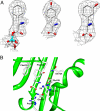Eukaryotic cytosolic and mitochondrial phenylalanyl-tRNA synthetases catalyze the charging of tRNA with the meta-tyrosine
- PMID: 19549855
- PMCID: PMC2700156
- DOI: 10.1073/pnas.0905212106
Eukaryotic cytosolic and mitochondrial phenylalanyl-tRNA synthetases catalyze the charging of tRNA with the meta-tyrosine
Abstract
The accumulation of proteins damaged by reactive oxygen species (ROS), conventionally regarded as having pathological potentials, is associated with age-related diseases such as Alzheimer's, atherosclerosis, and cataractogenesis. Exposure of the aromatic amino acid phenylalanine to ROS-generating systems produces multiple isomers of tyrosine: m-tyrosine (m-Tyr), o-tyrosine (o-Tyr), and the standard p-tyrosine (Tyr). Previously it was demonstrated that exogenously supplied, oxidized amino acids could be incorporated into bacterial and eukaryotic proteins. It is, therefore, likely that in many cases, in vivo-damaged amino acids are available for de novo synthesis of proteins. Although the involvement of aminoacyl-tRNA synthetases in this process has been hypothesized, the specific pathway by which ROS-damaged amino acids are incorporated into proteins remains unclear. We provide herein evidence that mitochondrial and cytoplasmic phenylalanyl-tRNA synthetases (HsmtPheRS and HsctPheRS, respectively) catalyze direct attachment of m-Tyr to tRNA(Phe), thereby opening the way for delivery of the misacylated tRNA to the ribosome and incorporation of ROS-damaged amino acid into eukaryotic proteins. Crystal complexes of mitochondrial and bacterial PheRSs with m-Tyr reveal the net of highly specific interactions within the synthetic and editing sites.
Conflict of interest statement
The authors declare no conflict of interest.
Figures



Similar articles
-
Bacterial and eukaryotic phenylalanyl-tRNA synthetases catalyze misaminoacylation of tRNA(Phe) with 3,4-dihydroxy-L-phenylalanine.Chem Biol. 2011 Oct 28;18(10):1221-9. doi: 10.1016/j.chembiol.2011.08.008. Chem Biol. 2011. PMID: 22035791
-
Chimeric human mitochondrial PheRS exhibits editing activity to discriminate nonprotein amino acids.Protein Sci. 2016 Mar;25(3):618-26. doi: 10.1002/pro.2855. Epub 2015 Dec 24. Protein Sci. 2016. PMID: 26645192 Free PMC article.
-
Structural and mutational studies of the amino acid-editing domain from archaeal/eukaryal phenylalanyl-tRNA synthetase.Proc Natl Acad Sci U S A. 2006 Oct 3;103(40):14744-9. doi: 10.1073/pnas.0603182103. Epub 2006 Sep 26. Proc Natl Acad Sci U S A. 2006. PMID: 17003130 Free PMC article.
-
Cytosolic aminoacyl-tRNA synthetases: Unanticipated relocations for unexpected functions.Biochim Biophys Acta Gene Regul Mech. 2018 Apr;1861(4):387-400. doi: 10.1016/j.bbagrm.2017.11.004. Epub 2017 Nov 16. Biochim Biophys Acta Gene Regul Mech. 2018. PMID: 29155070 Review.
-
Processivity of translation in the eukaryote cell: role of aminoacyl-tRNA synthetases.FEBS Lett. 2010 Jan 21;584(2):443-7. doi: 10.1016/j.febslet.2009.11.027. FEBS Lett. 2010. PMID: 19914240 Review.
Cited by
-
Identification of phenylalanine 3-hydroxylase for meta-tyrosine biosynthesis.Biochemistry. 2011 Jun 21;50(24):5401-3. doi: 10.1021/bi200733c. Epub 2011 May 31. Biochemistry. 2011. PMID: 21615132 Free PMC article.
-
Biological significance of RNA editing in cells.Mol Biotechnol. 2012 Sep;52(1):91-100. doi: 10.1007/s12033-012-9498-7. Mol Biotechnol. 2012. PMID: 22271460 Review.
-
Universal pathway for posttransfer editing reactions: insights from the crystal structure of TtPheRS with puromycin.Proc Natl Acad Sci U S A. 2015 Mar 31;112(13):3967-72. doi: 10.1073/pnas.1414852112. Epub 2015 Mar 16. Proc Natl Acad Sci U S A. 2015. PMID: 25775602 Free PMC article.
-
Toxicity of meta-Tyrosine.Plants (Basel). 2021 Dec 17;10(12):2800. doi: 10.3390/plants10122800. Plants (Basel). 2021. PMID: 34961269 Free PMC article. Review.
-
Investigating β-N-Methylamino-l-alanine Misincorporation in Human Cell Cultures: A Comparative Study with Known Amino Acid Analogues.Toxins (Basel). 2017 Dec 14;9(12):400. doi: 10.3390/toxins9120400. Toxins (Basel). 2017. PMID: 29240689 Free PMC article.
References
-
- Ibba M, Soll D. Aminoacyl-tRNA synthesis. Annu Rev Biochem. 2000;69:617–650. - PubMed
-
- Jakubowski H. Accuracy of aminoacyl-tRNA synthetases: Proofreading of amino acids. In: Ibba M, Francklyn C, Cusack S, editors. Aminoacyl-tRNA Synthetases. Austin, TX: Landes Bioscience; 2005. pp. 384–396.
-
- Hendrickson TL, de Crecy-Lagard V, Schimmel P. Incorporation of nonnatural amino acids into proteins. Annu Rev Biochem. 2004;73:147–176. - PubMed
-
- Stadtman ER. Protein oxidation and aging. Science. 1992;257:1220–1224. - PubMed
Publication types
MeSH terms
Substances
Associated data
- Actions
- Actions
Grants and funding
LinkOut - more resources
Full Text Sources
Other Literature Sources
Molecular Biology Databases

